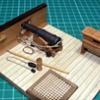HOLIDAY DONATION DRIVE - SUPPORT MSW - DO YOUR PART TO KEEP THIS GREAT FORUM GOING! (Only 68 donations so far out of 49,000 members - Can we at least get 100? C'mon guys!)
×
-
Posts
5,945 -
Joined
-
Last visited
Community Answers
-
BANYAN's post in Boat floors - what material? was marked as the answer
Hi Sizzolo, are you talking about the gratings/duck boards in the bottom of ship's boats? These came in two types as far as I am aware, but there are more experienced/knowledgeable people on this forum who may correct this.
Type 1 was constructed from widely spaced simple slats/planks laid longitudinally and shaped to conform with the inside of the hull. This may have required them being made in separate parts, or checke3d in around major ribs, stringers and the like.
Type 2 was constructed the same as a ship's hatch covering. These were made with a smaller grid (smaller battens and crosspieces, and laid the same as the slat type. Are these what you are talking about?
Also some gigs and pinnaces, used as the Admiral/Captain's barge/boat, had more elaborate furnishing and fittings. It is possible that the oiled canvas mats, similar in decor as the Captain/Admirals cabins, and as suggested by @barkeater were also used in their boats. The mats will simply have been laid/put down over the boat's decking. Obviously, these will have been of a much smaller size and grid pattern. I have attached a piccy I took in a fancy heritage house in Hobart, Tasmania which used painted canvas mats which look quite good IMHO. While this is much fancier than the typical checkerboard pattern it shows what they will have looked like.
Hope this helps?
cheers
Pat
-
BANYAN's post in how to secure a rope hank to the sheer poles? was marked as the answer
Paul, if lines were bent to the sheer poles, this would probably have been done using the tails of the line. The excess would first have been made up into coils, a length of the tail end then wrapped around the coils on their upper end, forming a sort of eye, through which the tail will have been passed. The length of the tail will have been long enough to form at least a clove hitch by which to bend it to the pole, but probably a little more to allow a constrictor hitch, or safety turns in addition to a clove hitch.
However, if carelessly/haphazardly bent to the pole, this could also have led to several of these made-up coils dangling and swinging freely if the pole was fitted much higher than the cap/roughtree rail. This would have imposed a significant hazard for the crew when stepping into the ratlines? This could be somewhat mitigated by bending them onto, or even around the shroud, near where the poles crossed them, leaving the parts between the shrouds clear to access/step-on? Hope this helps?
cheers
Pat


